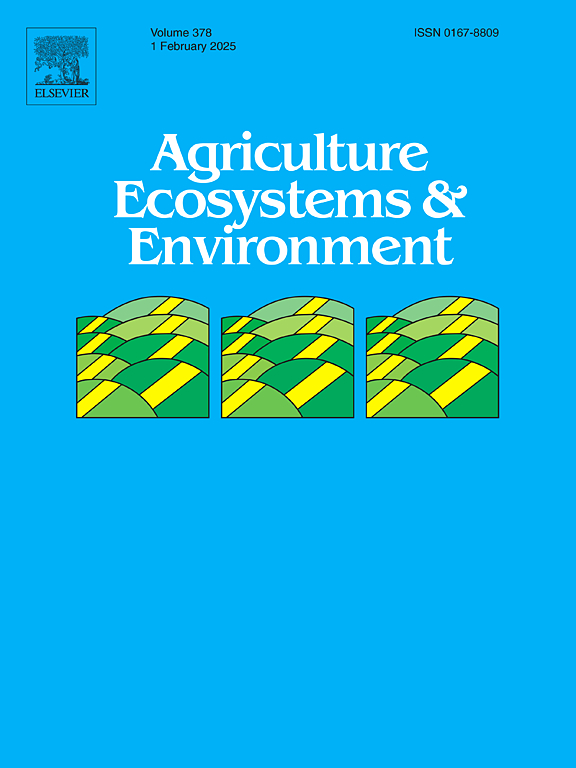Depth-dependent patterns in soil organic C, enzymatic stochiometric ratio, and soil quality under conventional tillage and reduced tillage after 55-years
IF 6
1区 农林科学
Q1 AGRICULTURE, MULTIDISCIPLINARY
引用次数: 0
Abstract
Interest in managing agroecosystems for improving soil health has driven the application of conservation practices, such as reduced tillage. However, our understanding remains limited regarding changes in soil organic carbon (SOC), microbial resource limitations, and soil ecosystem multifunctionality across the soil profile (not just in the upper layers) following long-term reduced tillage as compared to conventional tillage. This study aimed to compare the impacts of reduced tillage (RT) and conventional tillage (CT) on SOC storage, soil enzyme activities, and ecosystem functionality in a 90 cm soil profile. Soil cores were collected from four different soil depths (0–10, 10–30, 30–50, 50–90 cm) in a 55-year field experiment (crop rotation primarily featured cereals) in central Germany comparing RT (rotary harrow, 5–8 cm depth) and CT (mouldboard plough, 25 cm depth). Results showed that RT increases SOC content by 24 % at 0–10 cm depth but decreases SOC content by 22 % at 10–30 cm depth relative to CT. The enhanced SOC content under RT further improved soil ecosystem multifunctionality by a factor of 2.8 at 0–10 cm compared to CT. Notably, higher available nitrogen (N) content increased vector length at 0–10 cm depth under RT, related to the higher production and release of C-acquisition enzymes. In contrast, the higher exudation of N-acquiring enzymes found at 10–50 cm depth indicated N limitation for microorganisms under RT. At this depth, CT alleviated microbial N limitation. Moreover, RT lowered SOC stock by 24 % compared to CT at 10–30 cm, resulting in an 11 % decrease in SOC across the entire 0–90 cm soil profile. In conclusion, while reduced tillage improved soil ecosystem functionality in the 0–10 cm, it may not enhance SOC sequestration, highlighting the importance of considering the whole soil profile when comparing the SOC sequestration potential of different tillage practices.
55年后常规耕作和减少耕作条件下土壤有机碳、酶化学计量比和土壤质量的深度依赖模式
对管理农业生态系统以改善土壤健康的兴趣推动了诸如减少耕作等保护措施的应用。然而,与传统耕作相比,长期减少耕作对土壤有机碳(SOC)变化、微生物资源限制和土壤生态系统多功能性的影响仍然有限。本研究旨在比较90 cm土壤免耕(RT)和常规耕作(CT)对土壤有机碳储量、土壤酶活性和生态系统功能的影响。在德国中部进行为期55年的田间试验(作物轮作主要以谷物为主),从4种不同土壤深度(0-10、10-30、30-50、50-90 cm)收集土壤岩心,比较RT(旋转耙,5-8 cm深度)和CT(板犁,25 cm深度)。结果表明,相对于CT,在0 ~ 10 cm深度,RT使有机碳含量增加了24 %,而在10 ~ 30 cm深度,有机质含量减少了22 %。在0 ~ 10 cm范围内,土壤有机碳含量的提高进一步提高了土壤生态系统的多功能性,比CT提高了2.8倍。有效氮(N)含量的增加增加了RT下0-10 cm深度的载体长度,这与c获取酶的产生和释放有关。相比之下,在10-50 cm深度发现较高的N获取酶渗出,表明rt下微生物的N限制。在该深度,CT缓解了微生物的N限制。此外,与CT相比,在10-30 cm处,RT降低了24 %的有机碳储量,导致整个0-90 cm土壤剖面的有机碳减少了11 %。综上所述,虽然减少耕作改善了0-10 cm土壤生态系统功能,但可能不会增强有机碳的固存,因此在比较不同耕作方式的有机碳固存潜力时,必须考虑整个土壤剖面。
本文章由计算机程序翻译,如有差异,请以英文原文为准。
求助全文
约1分钟内获得全文
求助全文
来源期刊

Agriculture, Ecosystems & Environment
环境科学-环境科学
CiteScore
11.70
自引率
9.10%
发文量
392
审稿时长
26 days
期刊介绍:
Agriculture, Ecosystems and Environment publishes scientific articles dealing with the interface between agroecosystems and the natural environment, specifically how agriculture influences the environment and how changes in that environment impact agroecosystems. Preference is given to papers from experimental and observational research at the field, system or landscape level, from studies that enhance our understanding of processes using data-based biophysical modelling, and papers that bridge scientific disciplines and integrate knowledge. All papers should be placed in an international or wide comparative context.
 求助内容:
求助内容: 应助结果提醒方式:
应助结果提醒方式:


